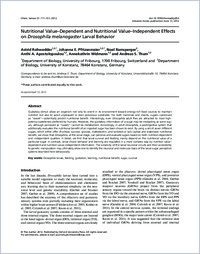Nutritional value–Dependent and nutritional value–Independent effects on Drosophila melanogaster larval behavior
- Rohwedder, Astrid Department of Biology, University of Fribourg, Switzerland and - Department of Biology, University of Konstanz, Germany
- Pfitzenmaier, Johanna E. R. Department of Biology, University of Fribourg, Switzerland and - Department of Biology, University of Konstanz, Germany
- Ramsperger, Noel Department of Biology, University of Konstanz, Germany
- Apostolopoulou, Anthi A. Department of Biology, University of Fribourg, Switzerland and - Department of Biology, University of Konstanz, Germany
- Widmann, Annekathrin Department of Biology, University of Fribourg, Switzerland and - Department of Biology, University of Konstanz, Germany
- Thum, Andreas S. Department of Biology, University of Fribourg, Switzerland and - Department of Biology, University of Konstanz, Germany
-
13.06.2012
Published in:
- Chemical Senses. - 2012, vol. 37, no. 8, p. 711-721
English
Gustatory stimuli allow an organism not only to orient in its environment toward energy-rich food sources to maintain nutrition but also to avoid unpleasant or even poisonous substrates. For both mammals and insects, sugars—perceived as “sweet”—potentially predict nutritional benefit. Interestingly, even Drosophila adult flies are attracted to most high-potency sweeteners preferred by humans. However, the gustatory information of a sugar may be misleading as some sugars, although perceived as “sweet,” cannot be metabolized. Accordingly, in adult Drosophila, a postingestive system that additionally evaluates the nutritional benefit of an ingested sugar has been shown to exist. By using a set of seven different sugars, which either offer (fructose, sucrose, glucose, maltodextrin, and sorbitol) or lack (xylose and arabinose) nutritional benefit, we show that Drosophila, at the larval stage, can perceive and evaluate sugars based on both nutrition-dependent and -independent qualities. In detail, we find that larval survival and feeding mainly depend on the nutritional value of a particular sugar. In contrast, larval choice behavior and learning are regulated in a more complex way by nutrition value–dependent and nutrition value–independent information. The simplicity of the larval neuronal circuits and their accessibility to genetic manipulation may ultimately allow one to identify the neuronal and molecular basis of the larval sugar perception systems described here behaviorally.
- Faculty
- Faculté des sciences et de médecine
- Department
- Département de Biologie
- Language
-
- English
- Classification
- Biological sciences
- License
- License undefined
- Identifiers
-
- RERO DOC 29551
- DOI 10.1093/chemse/bjs055
- Persistent URL
- https://folia.unifr.ch/unifr/documents/302565
Statistics
Document views: 98
File downloads:
- bjs055.pdf: 113
